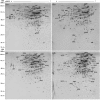Comparative transcriptomic and proteomic analysis of Arthrobacter sp. CGMCC 3584 responding to dissolved oxygen for cAMP production
- PMID: 29352122
- PMCID: PMC5775200
- DOI: 10.1038/s41598-017-18889-4
Comparative transcriptomic and proteomic analysis of Arthrobacter sp. CGMCC 3584 responding to dissolved oxygen for cAMP production
Abstract
Arthrobacter sp. CGMCC 3584 is able to produce high yields of extracellular cyclic adenosine monophosphate (cAMP), which plays a vital role in the field of treatment of disease and animal food, during aerobic fermentation. However, the molecular basis of cAMP production in Arthrobacter species is rarely explored. Here, for the first time, we report the comparative transcriptomic and proteomic study of Arthrobacter cells to elucidate the higher productivity of cAMP under high oxygen supply. We finally obtained 14.1% and 19.3% of the Arthrobacter genome genes which were up-regulated and down-regulated notably, respectively, with high oxygen supply, and identified 54 differently expressed proteins. Our results revealed that high oxygen supply had two major effects on metabolism: inhibition of glycolysis, pyruvate metabolism, nitrogen metabolism, and amino acid metabolism (histidine, branched-chain amino acids and glutamate metabolism); enhancement of the tricarboxylic acid cycle and purine metabolism. We also found that regulation of adenylate cyclase and phosphodiesterase was not significant under high oxygen supply, suggesting efficient cAMP export might be important in cAMP production. These findings may contribute to further understanding of capacities of Arthrobacter species and would be highly useful in genetic regulation for desirable production.
Conflict of interest statement
The authors declare that they have no competing interests.
Figures






Similar articles
-
Knockout of pde gene in Arthrobacter sp. CGMCC 3584 and transcriptomic analysis of its effects on cAMP production.Bioprocess Biosyst Eng. 2020 May;43(5):839-850. doi: 10.1007/s00449-019-02280-w. Epub 2020 Jan 10. Bioprocess Biosyst Eng. 2020. PMID: 31925506
-
Bi-stage control of dissolved oxygen to enhance cyclic adenosine monophosphate production by Arthrobacter A302.Bioprocess Biosyst Eng. 2012 Oct;35(8):1281-6. doi: 10.1007/s00449-012-0715-3. Epub 2012 Mar 1. Bioprocess Biosyst Eng. 2012. PMID: 22382444
-
Metabolic flux analysis of Arthrobacter sp. CGMCC 3584 for cAMP production based on 13C tracer experiments and gas chromatography-mass spectrometry.J Biotechnol. 2013 Dec;168(4):355-61. doi: 10.1016/j.jbiotec.2013.09.005. Epub 2013 Sep 19. J Biotechnol. 2013. PMID: 24056081
-
[Genomics basis of Arthrobacter spp. environmental adaptability– A review].Wei Sheng Wu Xue Bao. 2016 Apr 4;56(4):570-7. Wei Sheng Wu Xue Bao. 2016. PMID: 29717848 Review. Chinese.
-
Are 'light-derepressible' genes controlled by metal-protein complexes?Trends Biochem Sci. 1988 Oct;13(10):371-4. doi: 10.1016/0968-0004(88)90172-7. Trends Biochem Sci. 1988. PMID: 3072697 Review. No abstract available.
Cited by
-
Deep Functional Profiling Facilitates the Evaluation of the Antibacterial Potential of the Antibiotic Amicoumacin.Antibiotics (Basel). 2020 Apr 2;9(4):157. doi: 10.3390/antibiotics9040157. Antibiotics (Basel). 2020. PMID: 32252356 Free PMC article.
-
Understanding and Designing the Strategies for the Microbe-Mediated Remediation of Environmental Contaminants Using Omics Approaches.Front Microbiol. 2018 Jun 4;9:1132. doi: 10.3389/fmicb.2018.01132. eCollection 2018. Front Microbiol. 2018. PMID: 29915565 Free PMC article. Review.
-
Pneumococcal Phasevarions Control Multiple Virulence Traits, Including Vaccine Candidate Expression.Microbiol Spectr. 2022 Jun 29;10(3):e0091622. doi: 10.1128/spectrum.00916-22. Epub 2022 May 10. Microbiol Spectr. 2022. PMID: 35536022 Free PMC article.
References
Publication types
MeSH terms
Substances
LinkOut - more resources
Full Text Sources
Other Literature Sources
Molecular Biology Databases

